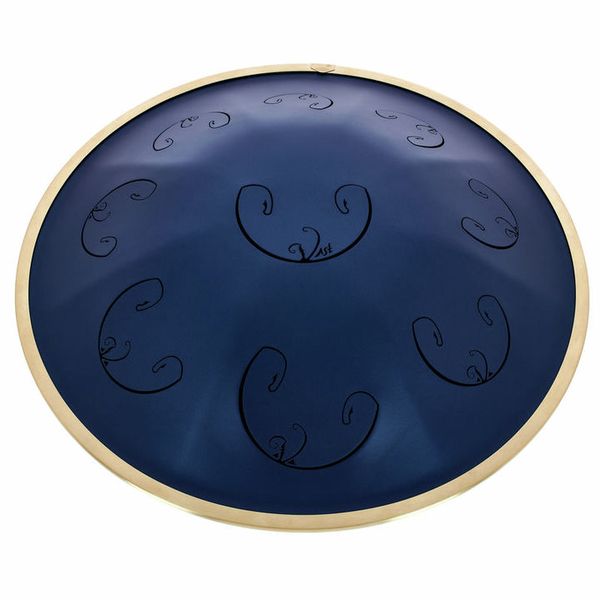The Handpan and the Rav Drum are two distinct percussion instruments that differ in their origin, construction, and sound. The Handpan is a convex steel shell with tone fields that are hammered into the metal, while the Rav Drum is a concave steel tongue drum with specific pitches and harmonics. The Handpan is played with the hands and produces a warm, mellow sound, while the Rav Drum is played with mallets or hands and produces a deep, resonant sound.
Differentiate Table Between A Handpan And A Rav Drum
| Feature | Handpan | Rav Drum |
|---|---|---|
| Shape | Convex | Concave |
| Construction | Two hemispherical shells, hammered tones | Steel tongue drum with specific pitches |
| Playing Technique | Played with the hands | Played with mallets or the hands |
| Sound | Warm and mellow | Deep and resonant, strong bass and overtones |
| Origin | Developed in Switzerland in 2001 | Developed in Russia in 2007 |
| Tuning | Specific scale or mode | Specific pitches, chromatic tuning |
| Number of notes | Typically 8-10 notes | Varies depending on model |
| Musical styles | Meditative, ambient, world music | Experimental, avant-garde, new age |
Origin and History
The Handpan, also known as the Hang or the Pantam, originated in Switzerland in the year 2001. The first Handpan was created by two Swiss steelpan makers, Felix Rohner and Sabina Schärer, who combined the principles of the Caribbean steelpan with new materials and techniques to create a unique musical instrument.

The Handpan has a convex steel shell with a series of indentations or “tone fields” that are hammered into the metal. The Handpan is played with the hands and produces a mellow, warm, and resonant sound that resembles a mix of a steel drum, a harp, and a vibraphone.
On the other hand, the Rav Drum was developed in Russia in 2007 by a Russian engineer, Andrey Remyannikov. The Rav Drum is a tongue drum that is made of steel and has a unique shape and layout of the tongues. Unlike the Handpan, which has a convex shape, the Rav Drum has a concave shape with a series of tongues that are cut and shaped to produce specific pitches and harmonics.

The Rav Drum is played with mallets or the hands and produces a deep, rich, and resonant sound that is reminiscent of a didgeridoo, a gong, and a steelpan.
Construction and Features
The Handpan and the Rav Drum differ significantly in their construction and features. The Handpan is made of high-quality steel that is carefully selected and processed to achieve the desired sound quality and durability. The Handpan is a single-piece instrument that is handcrafted by skilled artisans who spend several hours shaping, tuning, and polishing the steel shell and the tone fields.
The Handpan has a central note or “ding” in the middle of the shell, which serves as a reference point for the player and defines the tonality of the instrument. The Handpan also has several other notes arranged around the ding, which can be played by striking the tone fields with the fingertips or the palms of the hands.
The Rav Drum, on the other hand, is made of high-quality steel that is carefully selected and processed to achieve the desired sound quality and durability. The Rav Drum has a series of tongues that are cut and shaped from the steel shell to produce specific pitches and harmonics.
The Rav Drum is a multi-note instrument that has several tongues arranged in a circular or spiral pattern, depending on the model. The Rav Drum can be played with mallets or the hands, and the sound can be manipulated by varying the pressure and angle of the strike. The Rav Drum also has a resonance hole at the bottom, which enhances the sound and adds depth and sustain to the notes.
Playing Techniques and Sound
The Handpan and the Rav Drum require different playing techniques and produce distinct sounds. The Handpan is played with the hands, and the player uses a combination of finger strikes, palm slaps, and gliding movements to produce the desired notes and rhythms. The Handpan has a warm and mellow sound that is characterized by a rich harmonic spectrum and a long sustain. The Handpan is also versatile and can be played in different styles, such as jazz, world music, and new age.
The Rav Drum, on the other hand, is played with mallets or the hands, and the player uses a combination of striking, damping, and harmonics techniques to produce the desired notes and textures. The Rav Drum has a deep and resonant sound that is characterized by a strong bass and a rich overtone series. The Rav Drum is also versatile and can be played in different styles, such as ambient, meditative, and experimental.
Is Rav vast a handpan?
No, Rav Vast is not a handpan, but rather a tongue drum. While they share some similarities, such as being played with the hands and having a similar appearance, they have distinct differences in terms of construction, sound, and playing techniques.
What is the difference between a handpan and a tongue drum?
A handpan and a tongue drum differ in construction and sound. A handpan has a convex shape and is made from two hemispherical shells with tone fields that are hammered into the metal. In contrast, a tongue drum has a flat or concave shape and features tongues of various lengths and widths that are cut into the metal. The sound of a handpan is warm and mellow, while a tongue drum has a more percussive and metallic sound. Playing techniques also differ, as a handpan is played with the hands, while a tongue drum can be played with mallets or the hands.
What is the difference between a handpan and a steel drum?
A handpan and a steel drum are both percussion instruments made from steel, but they differ in construction, tuning, and playing techniques. A steel drum is a large, barrel-shaped instrument with a series of concave dents or pits, each of which produces a different note when struck. In contrast, a handpan is a smaller, convex steel shell with tone fields that are hammered into the metal. The tuning of a steel drum is chromatic, while a handpan is usually tuned to a specific scale or mode. Playing techniques also differ, as a steel drum is played with mallets, while a handpan is played with the hands.
Are there different types of handpans?
Yes, there are different types of handpans, each with its own unique sound and characteristics. Some of the most common types of handpans include the Hang, the Halo, the Zen Handpan, and the Pantheon Steel Halo. These instruments differ in terms of their scale, tuning, number of notes, and playing techniques. Some handpans may have a more mellow, meditative sound, while others may have a brighter, more percussive sound.
FAQs
Can the Handpan and the Rav Drum be played together?
Yes, the Handpan and the Rav Drum can be played together as they complement each other’s sounds and create a harmonious blend. Many musicians and percussionists use the Handpan and the Rav Drum in their compositions and performances.
Are the Handpan and the Rav Drum difficult to play?
Both the Handpan and the Rav Drum require some level of skill and practice to play effectively. However, with patience and dedication, anyone can learn to play these instruments and create beautiful music.
Can the Handpan and the Rav Drum be tuned?
Yes, both the Handpan and the Rav Drum can be tuned or retuned to different scales and modes. However, tuning the Handpan and the Rav Drum requires specialized tools and skills and should only be done by experienced professionals.
Conclusion
In summary, the Handpan and the Rav Drum are two distinct percussion instruments that have unique characteristics, construction, and sound. While the Handpan has a convex shape, a single central note, and produces a warm and mellow sound, the Rav Drum has a concave shape, several tongues arranged in a circular or spiral pattern, and produces a deep and resonant sound.
Both the Handpan and the Rav Drum require different playing techniques and offer a wide range of musical possibilities. Therefore, choosing between the Handpan and the Rav Drum depends on personal preferences, musical style, and playing goals.


